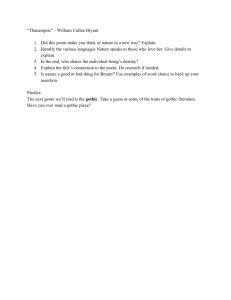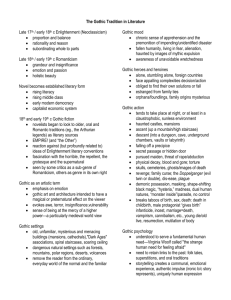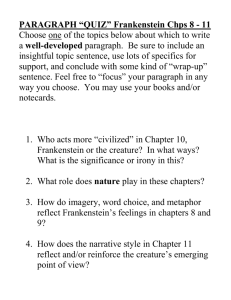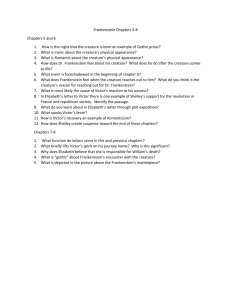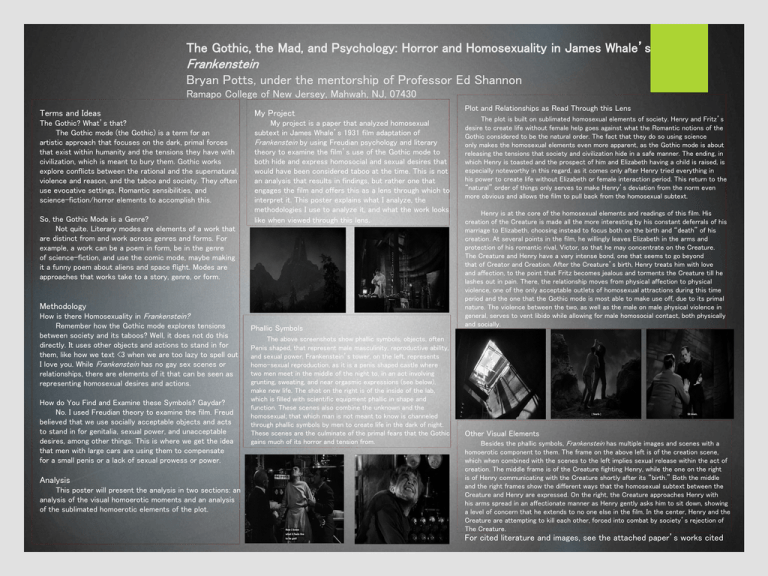
The Gothic, the Mad, and Psychology: Horror and Homosexuality in James Whale’s
Frankenstein
Bryan Potts, under the mentorship of Professor Ed Shannon
Ramapo College of New Jersey, Mahwah, NJ, 07430
Terms and Ideas
My Project
The Gothic? What’s that?
The Gothic mode (the Gothic) is a term for an
artistic approach that focuses on the dark, primal forces
that exist within humanity and the tensions they have with
civilization, which is meant to bury them. Gothic works
explore conflicts between the rational and the supernatural,
violence and reason, and the taboo and society. They often
use evocative settings, Romantic sensibilities, and
science-fiction/horror elements to accomplish this.
My project is a paper that analyzed homosexual
subtext in James Whale’s 1931 film adaptation of
Frankenstein by using Freudian psychology and literary
theory to examine the film’s use of the Gothic mode to
both hide and express homosocial and sexual desires that
would have been considered taboo at the time. This is not
an analysis that results in findings, but rather one that
engages the film and offers this as a lens through which to
interpret it. This poster explains what I analyze, the
methodologies I use to analyze it, and what the work looks
like when viewed through this lens.
So, the Gothic Mode is a Genre?
Not quite. Literary modes are elements of a work that
are distinct from and work across genres and forms. For
example, a work can be a poem in form, be in the genre
of science-fiction, and use the comic mode, maybe making
it a funny poem about aliens and space flight. Modes are
approaches that works take to a story, genre, or form.
Methodology
How is there Homosexuality in Frankenstein?
Remember how the Gothic mode explores tensions
between society and its taboos? Well, it does not do this
directly. It uses other objects and actions to stand in for
them, like how we text <3 when we are too lazy to spell out
I love you. While Frankenstein has no gay sex scenes or
relationships, there are elements of it that can be seen as
representing homosexual desires and actions.
How do You Find and Examine these Symbols? Gaydar?
No. I used Freudian theory to examine the film. Freud
believed that we use socially acceptable objects and acts
to stand in for genitalia, sexual power, and unacceptable
desires, among other things. This is where we get the idea
that men with large cars are using them to compensate
for a small penis or a lack of sexual prowess or power.
Analysis
This poster will present the analysis in two sections: an
analysis of the visual homoerotic moments and an analysis
of the sublimated homoerotic elements of the plot.
Phallic Symbols
The above screenshots show phallic symbols, objects, often
Penis shaped, that represent male masculinity, reproductive ability,
and sexual power. Frankenstein’s tower, on the left, represents
homo-sexual reproduction, as it is a penis shaped castle where
two men meet in the middle of the night to, in an act involving
grunting, sweating, and near orgasmic expressions (see below),
make new life. The shot on the right is of the inside of the lab,
which is filled with scientific equipment phallic in shape and
function. These scenes also combine the unknown and the
homosexual; that which man is not meant to know is channeled
through phallic symbols by men to create life in the dark of night.
These scenes are the culminate of the primal fears that the Gothic
gains much of its horror and tension from.
Plot and Relationships as Read Through this Lens
The plot is built on sublimated homosexual elements of society. Henry and Fritz’s
desire to create life without female help goes against what the Romantic notions of the
Gothic considered to be the natural order. The fact that they do so using science
only makes the homosexual elements even more apparent, as the Gothic mode is about
releasing the tensions that society and civilization hide in a safe manner. The ending, in
which Henry is toasted and the prospect of him and Elizabeth having a child is raised, is
especially noteworthy in this regard, as it comes only after Henry tried everything in
his power to create life without Elizabeth or female interaction period. This return to the
“natural” order of things only serves to make Henry’s deviation from the norm even
more obvious and allows the film to pull back from the homosexual subtext.
Henry is at the core of the homosexual elements and readings of this film. His
creation of the Creature is made all the more interesting by his constant deferrals of his
marriage to Elizabeth, choosing instead to focus both on the birth and “death” of his
creation. At several points in the film, he willingly leaves Elizabeth in the arms and
protection of his romantic rival, Victor, so that he may concentrate on the Creature.
The Creature and Henry have a very intense bond, one that seems to go beyond
that of Creator and Creation. After the Creature’s birth, Henry treats him with love
and affection, to the point that Fritz becomes jealous and torments the Creature till he
lashes out in pain. There, the relationship moves from physical affection to physical
violence, one of the only acceptable outlets of homosexual attractions during this time
period and the one that the Gothic mode is most able to make use off, due to its primal
nature. The violence between the two, as well as the male on male physical violence in
general, serves to vent libido while allowing for male homosocial contact, both physically
and socially.
Other Visual Elements
Besides the phallic symbols, Frankenstein has multiple images and scenes with a
homoerotic component to them. The frame on the above left is of the creation scene,
which when combined with the scenes to the left implies sexual release within the act of
creation. The middle frame is of the Creature fighting Henry, while the one on the right
is of Henry communicating with the Creature shortly after its “birth.” Both the middle
and the right frames show the different ways that the homosexual subtext between the
Creature and Henry are expressed. On the right, the Creature approaches Henry with
his arms spread in an affectionate manner as Henry gently asks him to sit down, showing
a level of concern that he extends to no one else in the film. In the center, Henry and the
Creature are attempting to kill each other, forced into combat by society’s rejection of
The Creature.
For cited literature and images, see the attached paper’s works cited

